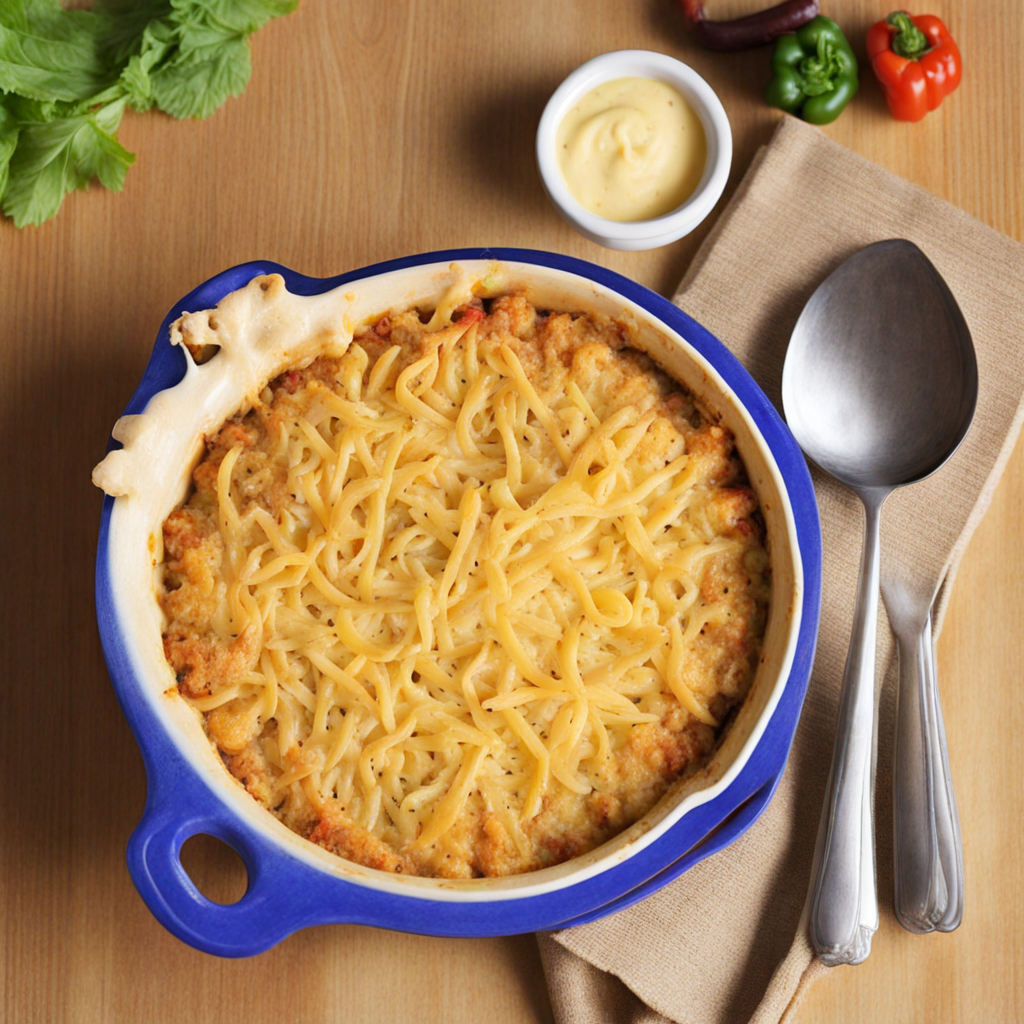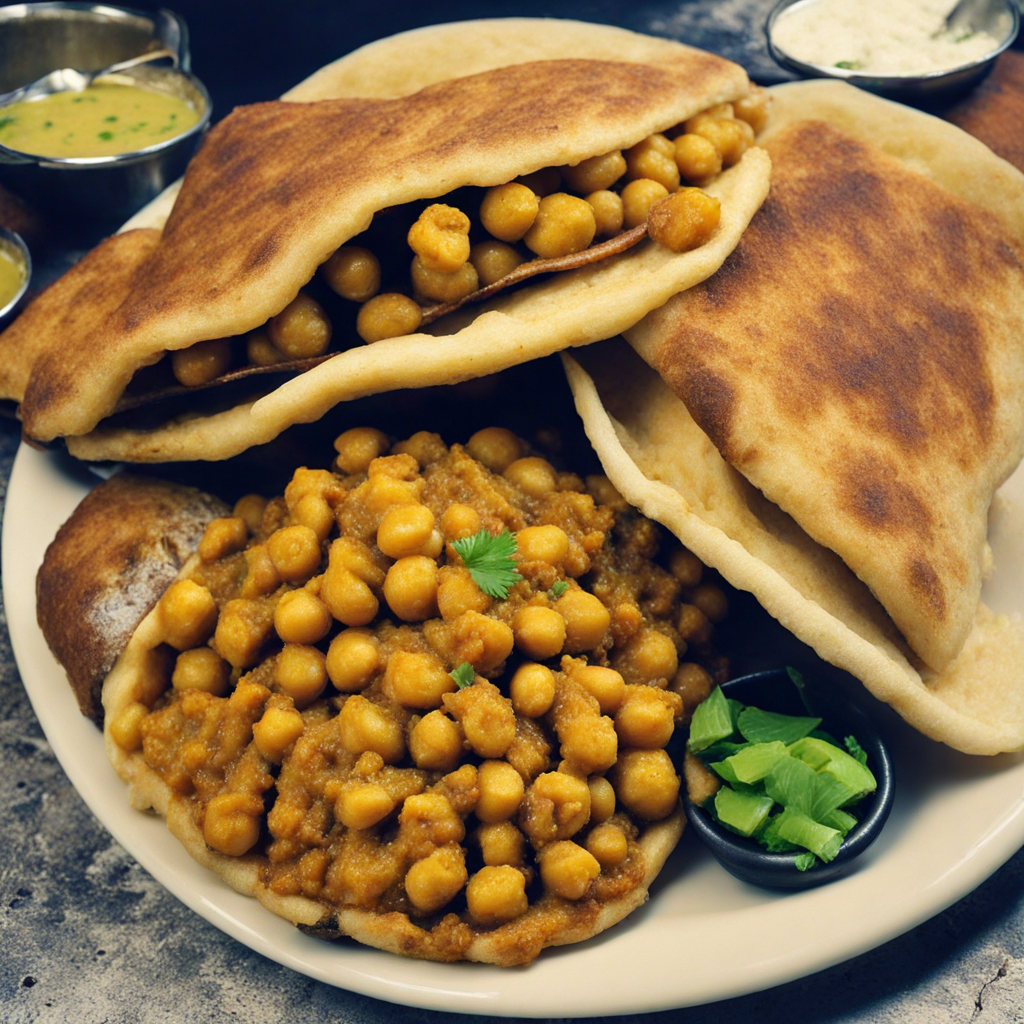Macaroni Pie
Macaroni Pie is a beloved dish from Trinidad and Tobago that beautifully captures the essence of Caribbean comfort food. At its core, this dish consists of macaroni pasta baked in a rich and creamy cheese sauce. The pasta is typically cooked until al dente and then combined with a mixture of sharp cheddar and sometimes other cheeses, creating a gooey, indulgent base. The addition of eggs lends a custardy texture, binding the ingredients together and giving the pie its characteristic firm yet tender structure once baked. The flavor profile of Macaroni Pie is further enhanced by the incorporation of various seasonings and spices, which reflect the vibrant culinary culture of Trinidad and Tobago. Ingredients such as mustard, black pepper, and sometimes even a hint of hot pepper provide a delightful kick, balancing the richness of the cheese. Additionally, some recipes include ingredients like chopped bell peppers, onions, or even bacalao (salted cod), adding layers of flavor and texture to this delicious dish. When baked to perfection, Macaroni Pie develops a golden, crispy top that contrasts beautifully with its creamy interior. It is often served as a side dish at festive occasions and family gatherings, but it can also stand alone as a satisfying meal. Each bite delivers a comforting blend of cheesy goodness and savory spices, making Macaroni Pie a must-try for anyone looking to explore the unique flavors of Trinidad and Tobago.
How It Became This Dish
The History of Macaroni Pie in Trinidad and Tobago Macaroni Pie, a beloved dish in Trinidad and Tobago, is more than just a simple comfort food; it is a culinary representation of the island's rich cultural tapestry, embodying influences from various cultures and traditions. This baked pasta dish, characterized by its creamy texture and cheesy flavor, has evolved over time to become a staple in Trinidadian cuisine, often featured in festivals, family gatherings, and even everyday meals. #### Origins and Early Influences The roots of Macaroni Pie can be traced back to the introduction of macaroni pasta to the Caribbean, primarily through European colonization in the 18th and 19th centuries. The British brought pasta and the concept of baked dishes to their Caribbean colonies, where local ingredients and culinary practices melded with European techniques. The dish is often compared to the Italian "pasta al forno" and the British "macaroni and cheese," both of which involve baking pasta with a creamy cheese sauce. However, the unique twist of Trinidadian Macaroni Pie lies in its use of local flavors and ingredients, reflecting the island's diverse cultural influences. Initially, macaroni was not a prominent feature in Trinidadian households; it was considered a luxury item, often reserved for special occasions. As the dish gained popularity, it came to symbolize a fusion of culinary traditions. The incorporation of local spices, cheeses, and vegetables transformed it into a distinctly Caribbean creation, making it a favorite among locals and visitors alike. #### Cultural Significance Macaroni Pie holds a special place in Trinidadian culture, often served during major celebrations such as Christmas, weddings, and family reunions. The dish is a symbol of togetherness and hospitality, embodying the spirit of Trinidadian communal dining. It is not uncommon for families to gather around a large dish of Macaroni Pie, sharing stories and laughter, creating lasting memories. The dish also reflects the broader cultural identity of Trinidad and Tobago, where influences from African, East Indian, Chinese, and European cuisines blend seamlessly. Each ethnic group has contributed its own unique touch to the dish. For instance, some families might add a hint of curry powder, reflecting the East Indian influence, while others might incorporate local cheeses or even hot peppers for a spicy kick. The adaptability of Macaroni Pie makes it a canvas for creativity, allowing cooks to infuse their personal and cultural flavors into the recipe. #### Development Over Time As Trinidadian society evolved, so too did the recipe for Macaroni Pie. The post-colonial era of the 1960s and 70s saw a resurgence of interest in local cuisine, as Trinidadians began to reclaim and celebrate their culinary heritage. The dish became emblematic of this movement, representing a fusion of different culinary traditions and a celebration of local culture. In the late 20th century, the availability of ingredients and the influence of global food trends began to shape the recipe further. The introduction of processed cheeses and convenience foods made it easier for families to prepare Macaroni Pie quickly. As a result, the dish became a staple in many households, often appearing in potluck gatherings and community events. It was during this time that variations of the pie began to emerge, with some families opting for vegetarian versions, adding vegetables such as spinach or peppers, while others included meats like chicken or ham. The 21st century has seen an increase in the popularity of Macaroni Pie beyond the borders of Trinidad and Tobago. With the rise of the global food movement and the internet, Trinidadian cuisine has gained international recognition. Macaroni Pie has become a symbol of Caribbean culinary culture, featured in food festivals and restaurants around the world. Chefs have begun to experiment with the dish, adding contemporary twists such as gourmet cheeses, truffle oil, or even lobster, while still honoring the traditional roots of the recipe. #### Ingredients and Preparation While the core ingredients of Macaroni Pie remain consistent—macaroni pasta, cheese, milk, and eggs—the preparation method can vary widely among families. Traditional recipes often include a combination of cheeses such as cheddar and Parmesan, seasoned with local spices like nutmeg and black pepper. The base is typically made by cooking the macaroni until al dente, then mixing it with a creamy egg and milk mixture before baking it to a golden-brown perfection. One of the unique aspects of Macaroni Pie is its versatility. It can be served as a side dish alongside other Trinidadian staples such as fried chicken, curry dishes, or stews, or enjoyed as a main course. Some families even prepare it with a crust, reminiscent of a savory pie, while others prefer a more rustic approach, allowing the edges to crisp up in the oven. #### Modern-Day Macaroni Pie Today, Macaroni Pie continues to be a beloved dish in Trinidad and Tobago, embodying the essence of the islands' culinary heritage. The rise of social media has allowed for a new generation of cooks to share their family recipes and innovative takes on the dish, further ensuring its place in contemporary Trinidadian cuisine. Food bloggers, chefs, and home cooks alike are exploring new ingredients and flavor combinations, while still paying homage to the traditional methods of preparation. As Trinidadians continue to celebrate their diverse cultural influences, Macaroni Pie stands as a testament to their culinary creativity and adaptability. It is a dish that not only nourishes the body but also feeds the soul, bringing people together and fostering a sense of community. #### Conclusion In summary, Macaroni Pie is a dish that encapsulates the history and cultural significance of Trinidad and Tobago. From its European origins to its transformation into a beloved Caribbean staple, it reflects the island's rich culinary heritage and the blending of diverse traditions. As it continues to evolve, Macaroni Pie remains a cherished part of Trinidadian life, symbolizing togetherness, creativity, and the joy of sharing a meal with loved ones. Whether enjoyed at a festive gathering or as a comforting weeknight dinner, it is a dish that resonates with the heart and soul of the islands.
You may like
Discover local flavors from Trinidad And Tobago







